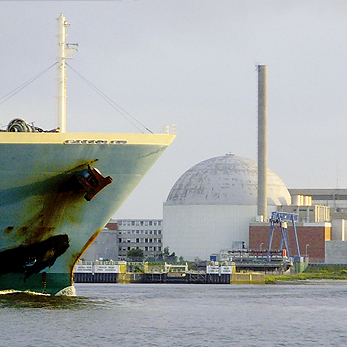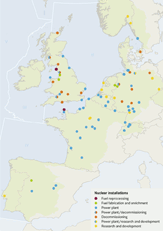What are the problems?
Radioactive substances affect living organisms
Radioactivity is associated with energy released from radionuclides through radiation. Ionising radiation occurs as electromagnetic rays (γ-rays), α-particles and β-particles. It can cause genetic, reproductive and cancerous effects in living organisms. Because of this, it has the potential to cause negative effects on marine organisms at the level of populations and to affect human health through seafood consumption. The potential for harm through radiation depends on the properties of the radionuclides, the amount of radiation energy absorbed by marine organisms (i.e. the dose) and the pathway through which they are exposed: γ-rays and β-particles can penetrate the skin, while α-particles cannot, but are particularly dangerous if ingested or inhaled.
The main sources from which radioactive substances are discharged into the OSPAR area are the nuclear sector (associated with electricity generation) and the non-nuclear sector (mainly the offshore oil and gas industry and medical uses).
The nuclear sector is the main source of artificial radionuclides
The number of nuclear installations in OSPAR countries discharging radionuclides directly or indirectly to the OSPAR area has been stable over the past ten years. In 2007, the 92 nuclear installations in operation and decommissioning in the OSPAR catchment comprised: nuclear power plants, which harness the heat produced in nuclear reactions and convert this to electrical energy; nuclear fuel fabrication and enrichment plants, which provide the uranium fuel for the power plants; nuclear fuel reprocessing plants, which recycle used nuclear fuel to recover uranium and plutonium; and research and development facilities relating to all aspects of the nuclear sector Figure 6.1.
Nuclear fuel reprocessing plants and fuel fabrication and enrichment plants account for 98% of discharges of radionuclides from the nuclear sector. The radionuclides that are used as indicators of discharges from this sector are caesium-137 (137Cs), technetium-99 (99Tc), plutonium-239 (239Pu), plutonium-240 (240Pu), and tritium (3H) Table 6.1. Inputs of radionuclides to the sea are associated with liquid discharges and to a lesser extent with solid wastes and emissions to air.
Offshore oil and gas activities discharge naturally occurring radionuclides
The offshore oil and gas industry is the largest non-nuclear contributor of discharges of radioactive substances to the marine environment. Almost all the radionuclides discharged from this sector are from produced water (water extracted from the reservoir with the oil and gas) and from descaling the insides of pipes. A less important source is the use of radioactive substances (e.g. tritium) as tracers. The naturally occurring radionuclides in produced water include lead-210 (210Pb), polonium-210 (210Po), and radium-226 and -228 (226Ra and 228Ra).
Other non-nuclear sources are minor
The main source of radioactive discharges in the medical sector is from the use of radioactive iodine-131 (131I) in the treatment of thyroid complaints Table 6.1. However, its short half-life and discharge via sewers means that only negligible levels of 131I reach the marine environment.
Waste from the phosphate fertiliser industry was an important source of naturally occurring radionuclides to the marine environment until the early 1990s. All discharges from this industry ceased by 2005, due to plant closures and the use of operating systems that avoid discharges. Yet, past discharges still contribute to environmental concentrations and radiation doses.


